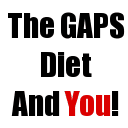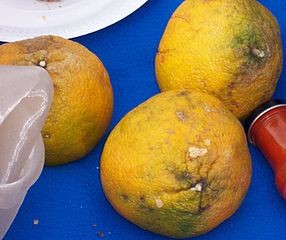The GAPS Diet: Don’t Be a Victim to Your Digestion Anymore!
Just What Is This GAPS Diet You Keep Hearing About?
 The GAPS diet was created by Dr. Natasha Campbell-McBride. Dr. Campbell-McBride is a neurologist and nutritionist who specializes in treating disorders such as, autism, ADD and ADHD, and a host of other conditions that plague both children and adults.
The GAPS diet was created by Dr. Natasha Campbell-McBride. Dr. Campbell-McBride is a neurologist and nutritionist who specializes in treating disorders such as, autism, ADD and ADHD, and a host of other conditions that plague both children and adults.
She adapted her own version of the Specific Carbohydrate Diet (SCD) that was created by Dr. Sydney Valentine Haas. Dr. Haas created the diet to correct the digestive disorders that so many people suffer with. The book and diet created a huge buzz when a parent helped to heal her own son after following the eating plan.
Dr. Campbell-McBride took this valuable information to the next level to create an eating program like no other. Dr. Campbell-McBride is a parent, maybe just like you. She had a child who was diagnosed with learning disabilities and wanted to get to the root of the problem and she did!
Dr. Campbell-McBride learned that there is a strong link between learning disabilities, the foods that we consume, and the health of our digestive systems. The results from her work have astonished the medical field and proven that her notions are correct.
So what does this all mean for you?
The GAPS diet is a diet that begins with the introduction of the diet. This first part of the diet works to eliminate most foods and then slowly add them in to watch for digestion issues. In the beginning, clear broths, vegetables that are easy to digest, boiled meats, and soups are the bulk of the plan. A big component of the GAPS diet is that you will eat tons of fermented vegetable soup! Fermentation involves converting the carbohydrates in the vegetables to alcohol through the natural bacteria and yeast found in the air. Don’t worry, you are not going to get drunk by eating the soup!
The complete gist of the diet is that you use homemade broths made from bones and fermented vegetables to heal the digestive tract. The use of probiotics and juices from fermented vegetables may not sound very appetizing; but trust me it does get better! This diet can completely change the way your digestive tract works and it can reverse learning disabilities and neurological problems, such as Autism and ADD.
The diet involves eating these very basic and primal meals until the symptoms of digestive distress stop. Once this happens, more foods can be added back in slowly and one at a time. Yes, this may seem like a big pain, but it is worth it to achieve maximum health and change in your neurological system! Dr. Campbell-McBride recommends slowly adding in more fruits and vegetables to the diet. She advises her patients to put a small amount of the juice from a fruit or vegetable on the inner wrist of the child, leaving this to dry overnight. If the parent notices a swollen and red area on the wrist, that food should be avoided. If there is no redness or swelling, the food can be introduced with caution.
The GAPS diet is not very easy in the beginning. Children who are used to eating certain foods are probably going to balk when you put boiled meats and vegetables in front of them instead of pizza and mac n’ cheese! Most adults are not going to be fond of this eating plan in the beginning either. Trust me, if you can stick with it, you will see major changes! Though the introduction diet is the first phase of the eating plan, many users find it too difficult to do, so they proceed with the full GAPS diet and later come back to the more restrictive methods once they have gotten their feet wet. Though this diet isn’t for everyone, countless people are using these methods and finding great relief!
 Is the GAPS Diet for You?
Is the GAPS Diet for You?
So who is the GAPS diet for? Is it for you? The GAPS diet works well for almost anyone. Some people find that they need to adjust the diet in some form so that it is not so restrictive. Many children have been placed on the diet by their parents and their gastrointestinal issues have vanished. Still others have seen their children healed from their learning disabilities.
While Dr. Campbell-McBride formulated this eating plan for parents who have children with learning issues and other neurological problems, the diet is being used by many adults as well (myself included). Some parents choose to follow the diet plan along with their children as a motivation for the child and find that their stomach issues and neurological issues begin to improve dramatically.
As with any diet or eating plan, you should consult with your doctor before you dive in head first into a diet that may not be for you. Most people have no issues with the diet, but reviews do include those who end up feeling weak and lethargic (even though this is normal the 1st week). Some people may find that eliminating too many foods is too difficult for their bodies to handle. Taking a slow approach can help.
While this eating plan is said to help with many glandular issues, those who suffer with adrenal gland problems are often not able to continue with the diet within the full parameters that it suggests. Working with a nutritionist can help those who otherwise would not be able to follow the eating plan, because the nutritionist can help formulate an eating plan that is based on the GAPS diet, but allows for more customization to meet the nutritional needs of each person.
 The Good, the Bad, and the Ugly
The Good, the Bad, and the Ugly
So, do you want to hear the bad or the good first? How about we get the bad out of the way? There are some foods that are considered “bad” on the GAPS diet. These foods are eliminated in the diet not because they are bad, but because they can cause problems with digestion in those with problematic digestive tracts. It’s not that the food itself is bad, it’s just these are foods that should be avoided if at all possible.
- Lactose is to be avoided at all costs! However, lactose-free homemade yogurt is allowed (and delicious)
- Commercially prepared condiments
- Pasta of any kind
- Commercially salted nuts
- Processed sugar of any kind (yes, I know!… It was difficult for me too, at first)
- Wheat
- Potatoes (all kinds)
- Rice
- Chewing gum (who would have thought!)
- And the worst of it all, no chocolate!
[blank]
Now let’s get into what we can have! No one wants to be told that they can’t have something, so let’s focus on what can be eaten on this plan. Though there are limits on the introduction plan, there are many choices after you enter into the full plan.
- Fresh eggs
- Some cheeses
- Peanut Butter (or any nut butter) with no additives (Yum!)
- Meats, poultry, fish and shellfish
- Fruits
- Almost all vegetables (with a few exceptions)
- Nuts
- Honey
- Many spices
[blank]
While this is in no way a comprehensive listing, you can find much more information on the link at the end of this article. It gives a listing of many foods that you can have and those that you cannot. Try to remember when you are looking at these lists, that you are doing this for your health. Take baby steps into the diet. You may want to try it a day or two here and there to get the hang of it.
Oh, and I almost forgot, the ugly! You can have Ugly fruit on this eating plan! (Yes, there truly is a fruit called Ugli fruit… with an “i”!) – here it is:

The Ugli Fruit…
We All Make Mistakes!
There are several common mistakes that people make when they are trying the GAPS diet. I hope to help you avoid these mistakes so that you can have a much better experience as you enter this eating plan. There are five big mistakes that GAPS users make and it has detrimental effects on the success of the plan!
- This plan requires the use of good probiotics. When I say good, I mean the expensive kind. If you think that you can go to the dollar store and buy a bottle of probiotics and do well on this plan, then you are sadly mistaken! What is even worse, is that some users of the plan do not take probiotics at all. The major premise of the plan is using probiotics to heal the intestinal tract and get the flora back in order. Why even bother to do the diet if you are not gonna stick with the most important part? Dr. Campbell-McBride warns in her book that most probiotics do not have the strains of bacteria that are listed on the label or the strengths that are promised.
- Many people make the mistake of cutting out their grains, but still have their potatoes. The whole point of this eating plan is to eliminate all forms of disaccharides. All grains and sugars contain disaccharides. Though starches are not technically disaccharides, they act in the much the same way and cause undigested food to accumulate in the tract. Again, why bother if you are not going to do it right?
- Not eating enough bone protein broths. Yes, it sounds really gross; but eating broths made from bones is one of the most important parts of this eating plan. You must eat tons of broth to get the true benefits of the GAPS plan. You can’t expect to go buy cans of beef broth from your grocery store and expect to make this work. You must take the time to make these broths from scratch. So put on your apron and get to work!
- Another big mistake that people make on the plan is that they try to fill up their diets with non-grain sources of flour. This is going to backfire, it truly is. If you try to eat almond flour and other types of flour until you are stuffed, you are going to be just that-stuffed! Stuffed with thick, undigested food that causes you to continue to have symptoms.
- And here we are to the biggest mistake that many people make….They give up before they even give the plan a true chance! Many people try this diet and expect to get their good health back instantly! This is not going to happen! While you will see results rather quickly, it can take 18 months to 2 years before complete healing and restoration takes place.
[blank]
If you will avoid these five common mistakes, you will see better results on the eating plan and won’t be wasting your time. Since this is such a big change, why should you bother with the hassle of such limitations if you plan on not following the plan as it was written?
 GAPS Diet Myths Debunked
GAPS Diet Myths Debunked
Unlike the Loch Ness Monster, the myths that continue to circulate about the GAPS diet can be debunked!
Many people hear these myths and believe them to be true without ever investigating for themselves. It is important if you are going to change the way you eat, and change it so drastically, that you take the time to read the book, to research the plan, and to fully understand what you are getting yourself into (if you have questions, don’t hesitate to ask me via the commenting system).
- The biggest misconception of the GAPS diet is that you will have to stay on it forever! This is wrong! The GAPS diet was never intended to be a permanent way of eating. It is a temporary plan that allows users to heal their digestive tracts, thus healing other ailments. Once healing has taken place, there is no need to stay on the diet plan. Most people do the diet for around a year, but some stay on it for two years (and others for life).
- Many people still believe that this is a low-carb eating plan. Again, this is wrong! You are still allowed carbs from fruits and vegetables and other sources. Many types of carbs are eliminated, but you are still able to enjoy some.
- One of the biggest myths associated with the GAPS diet is that people can never recover from food allergies. This is a big lie! The truth is people can and do recover from food allergies on this plan! While some may have to avoid certain foods forever, most people can heal from their allergies and go on to eat these foods again.
- Many users confuse the GAPS diet with the Paleo diet and think that they are the same thing. This is also false. While these two eating plans are similar, they are also very different. One huge difference is that the Paleo diet does not allow any dairy, while the GAPS diet does.
- Another factor that people assume about the GAPS diet is that grains are bad for us. This could not be further from the truth and this is yet another difference with the Paleo diet. In GAPS, grains are not inherently bad, they should just be avoided while the gut is healing. Dr. Campbell-McBride says in her book that users can incorporate grains and potatoes back into their diets once they come off of the GAPS plan.
[blank]
So, there you have it… the basics of the GAPS plan. Only you can decide if this plan is for you. You should read the book by Dr. Campbell-McBride and do as much research as you can before you make a final decision.
Resources:
http://www.gutandpsychologysyndrome.com/wp-content/uploads/2009/11/GAPS-Diet-Foods.pdf
4 Responses
Thanks for the link to the list, but why is chestnut flour forbidden? It was my only means of putting up with a non gluten regime.
Hi Liz,
The SCD and GAPS diets exclude all starches. Chestnuts are very starchy unlike other nuts like almonds.
At home we cook a lot with almond flour – it is a good option to consider.
“The truth is that 99% of people can and do recover from food allergies on this plan!”
That’s a very big claim. Do you have any evidence to support such a huge rate of succeess??
Hi Reilly,
Thanks for pointing that out – that was a big claim indeed, I have updated the article.